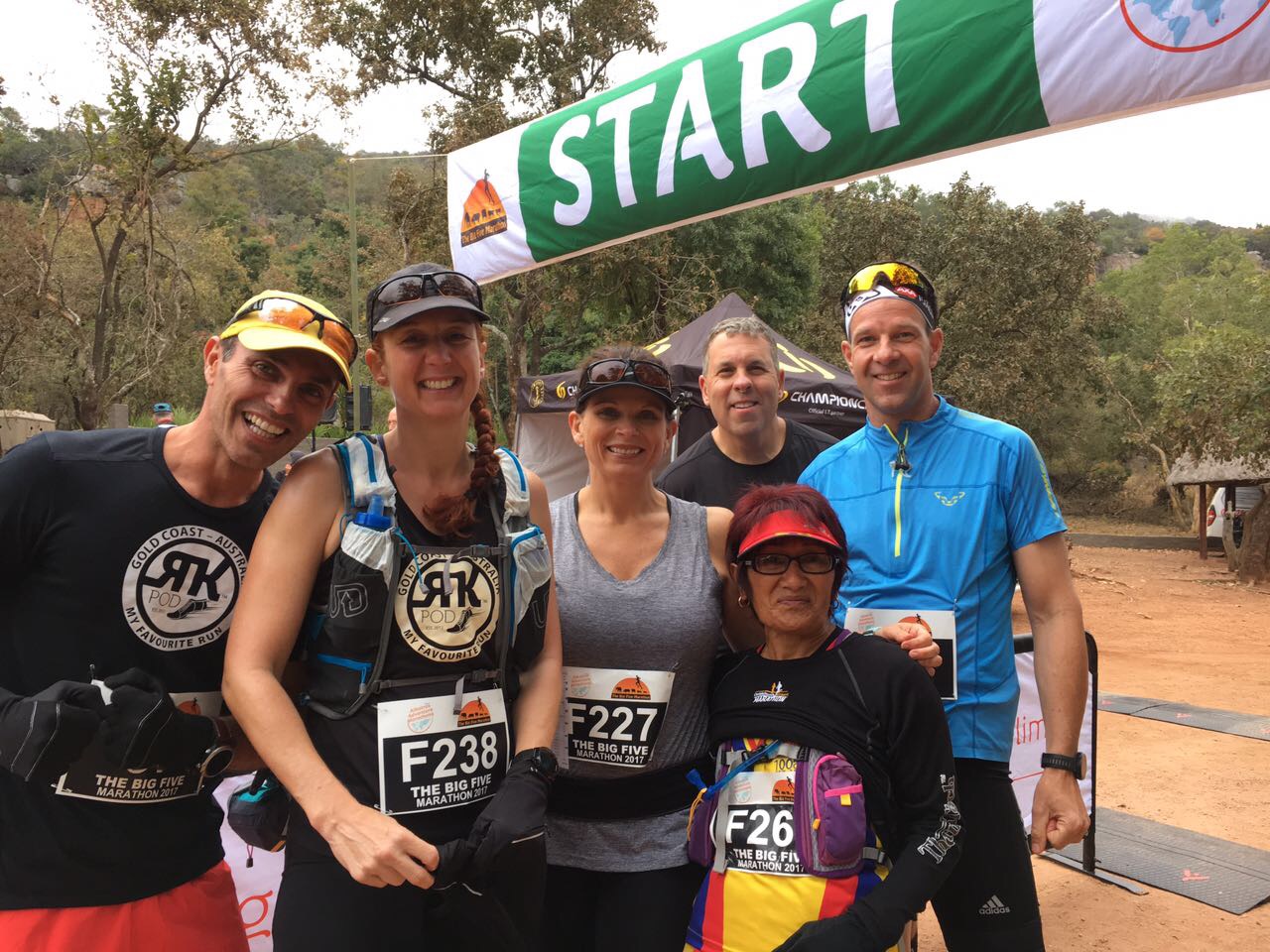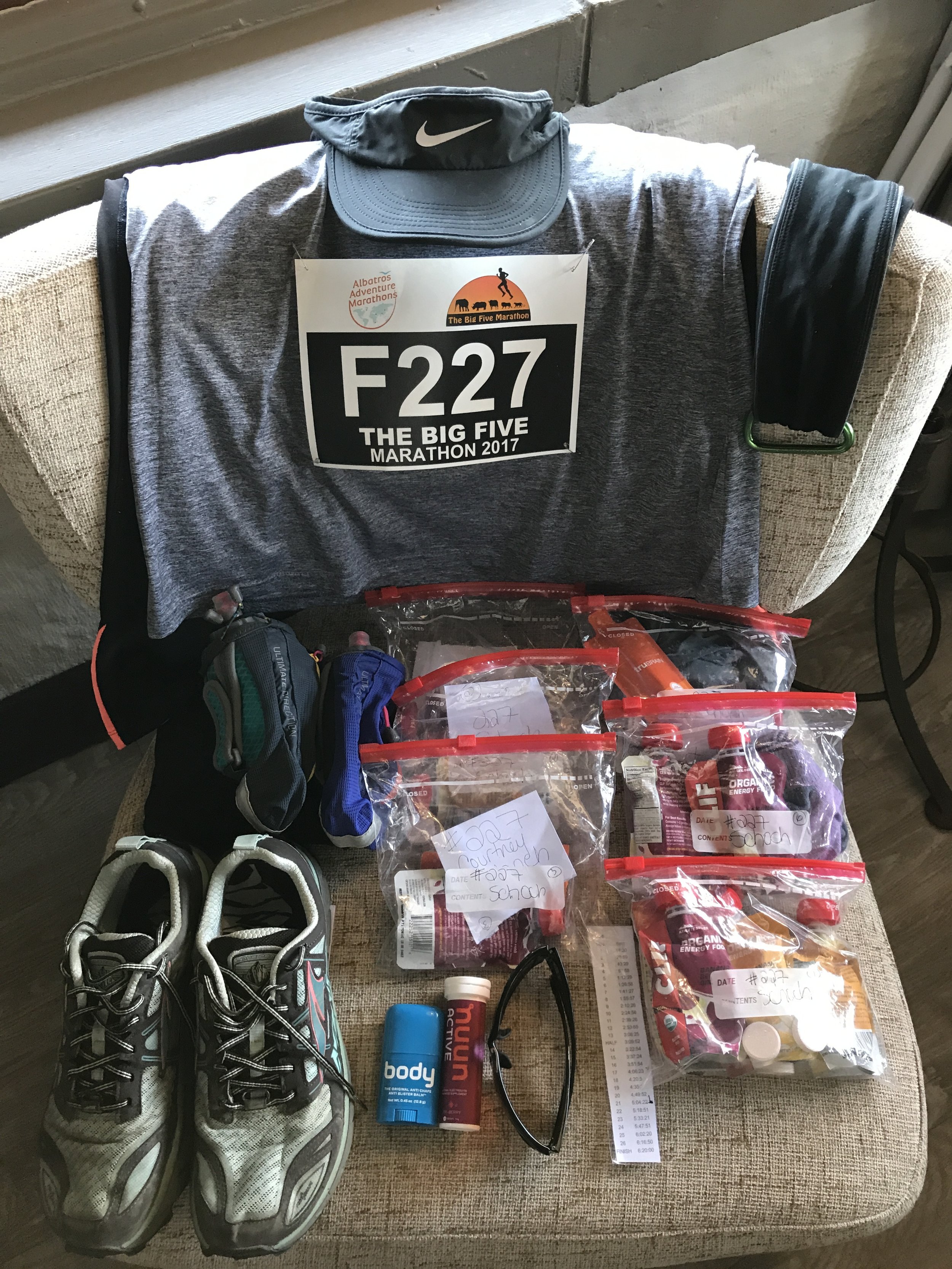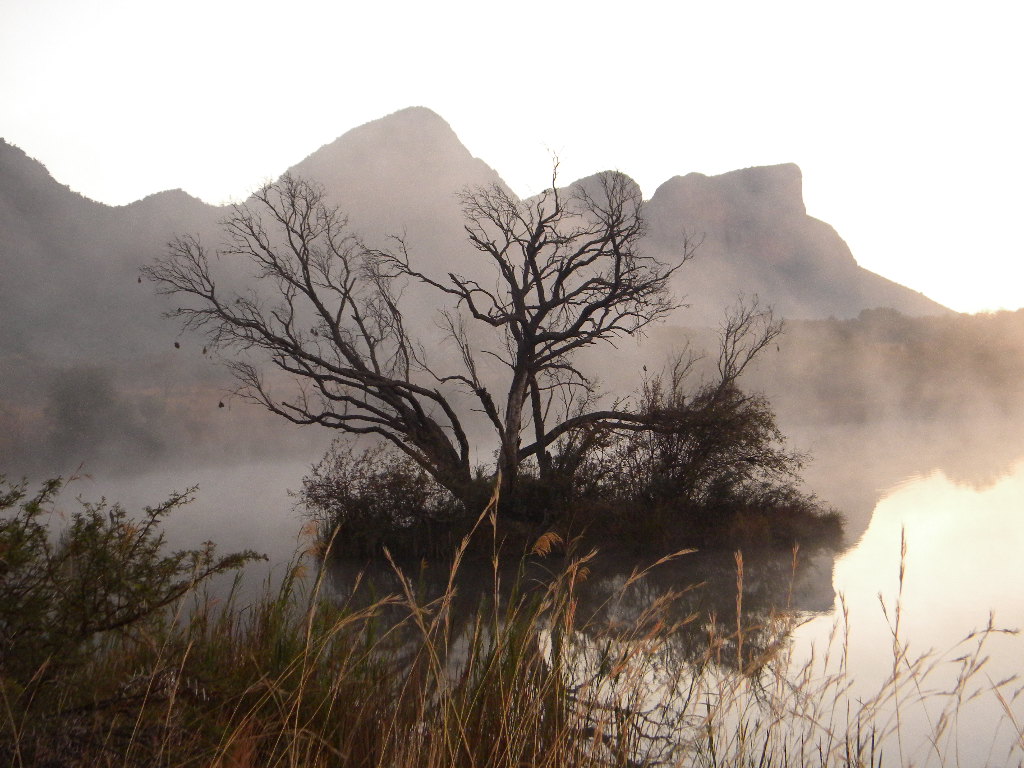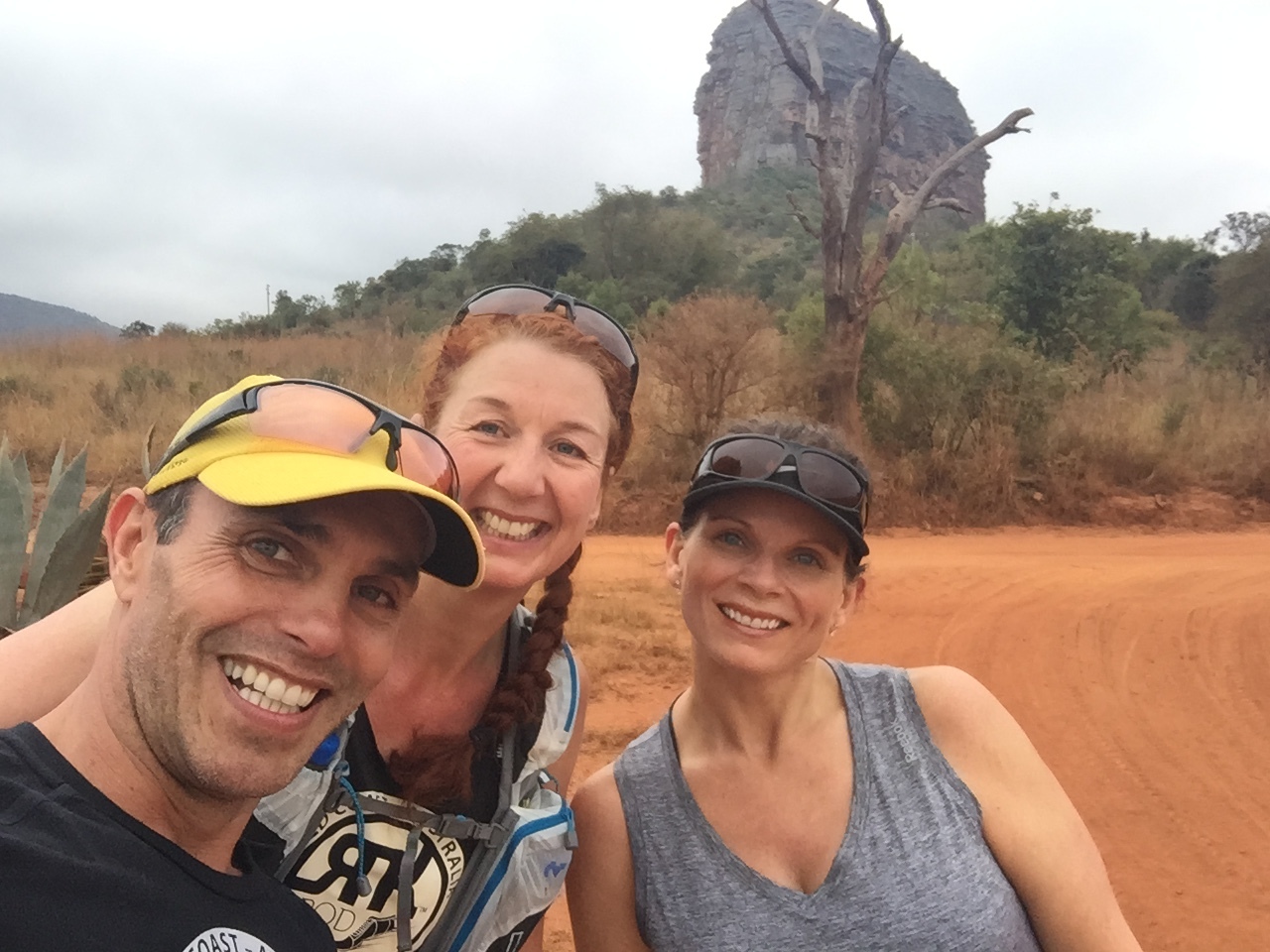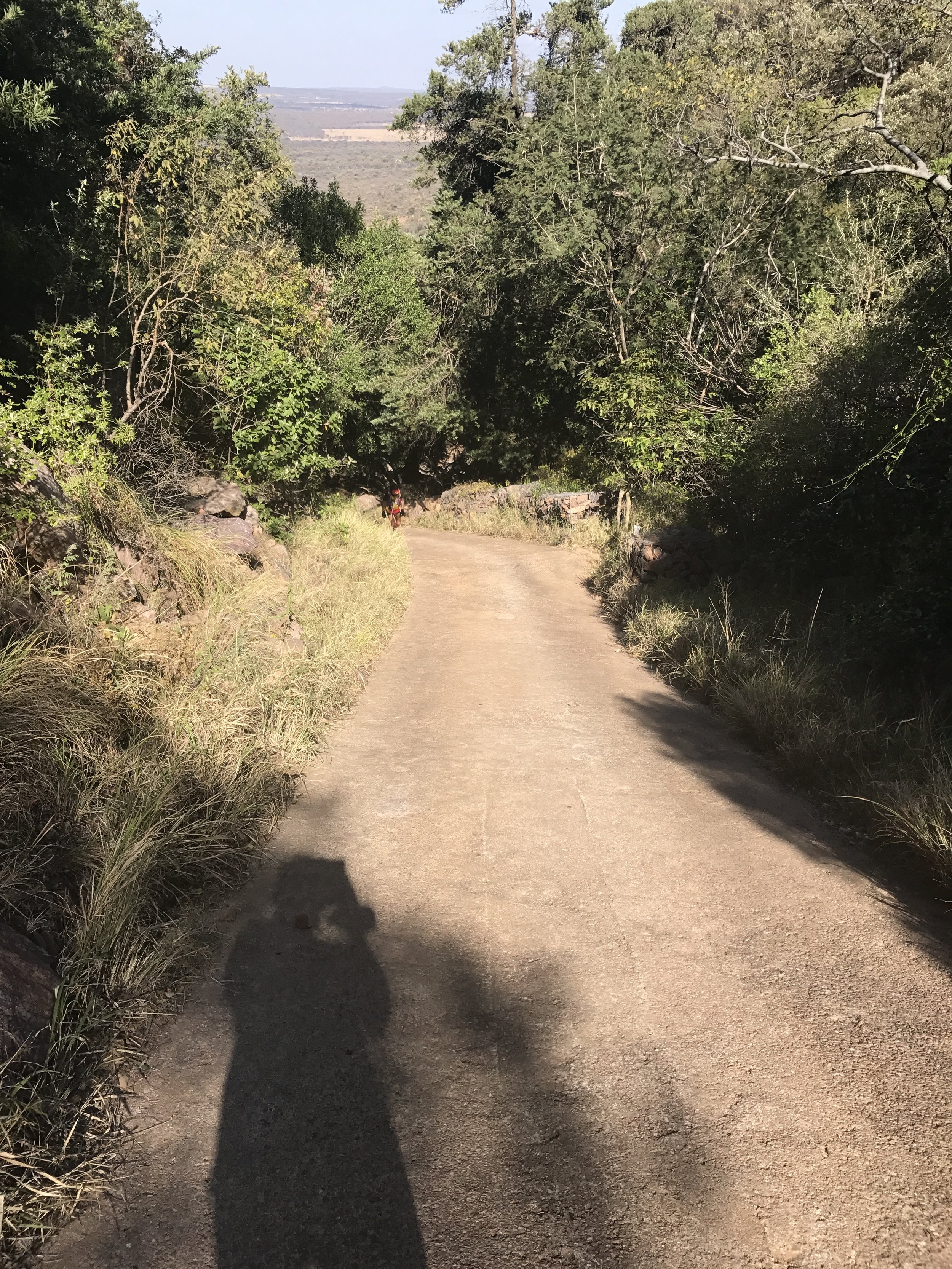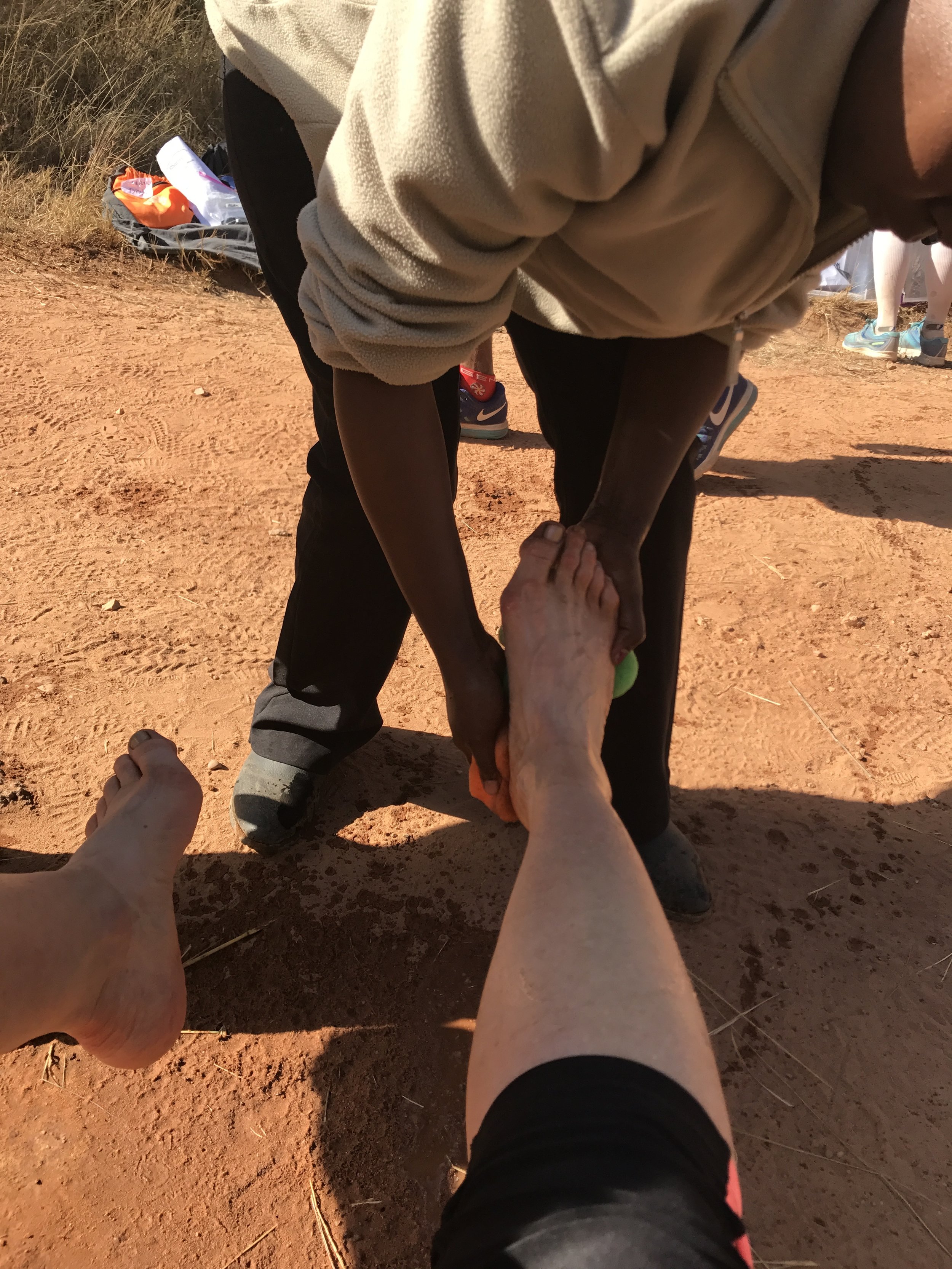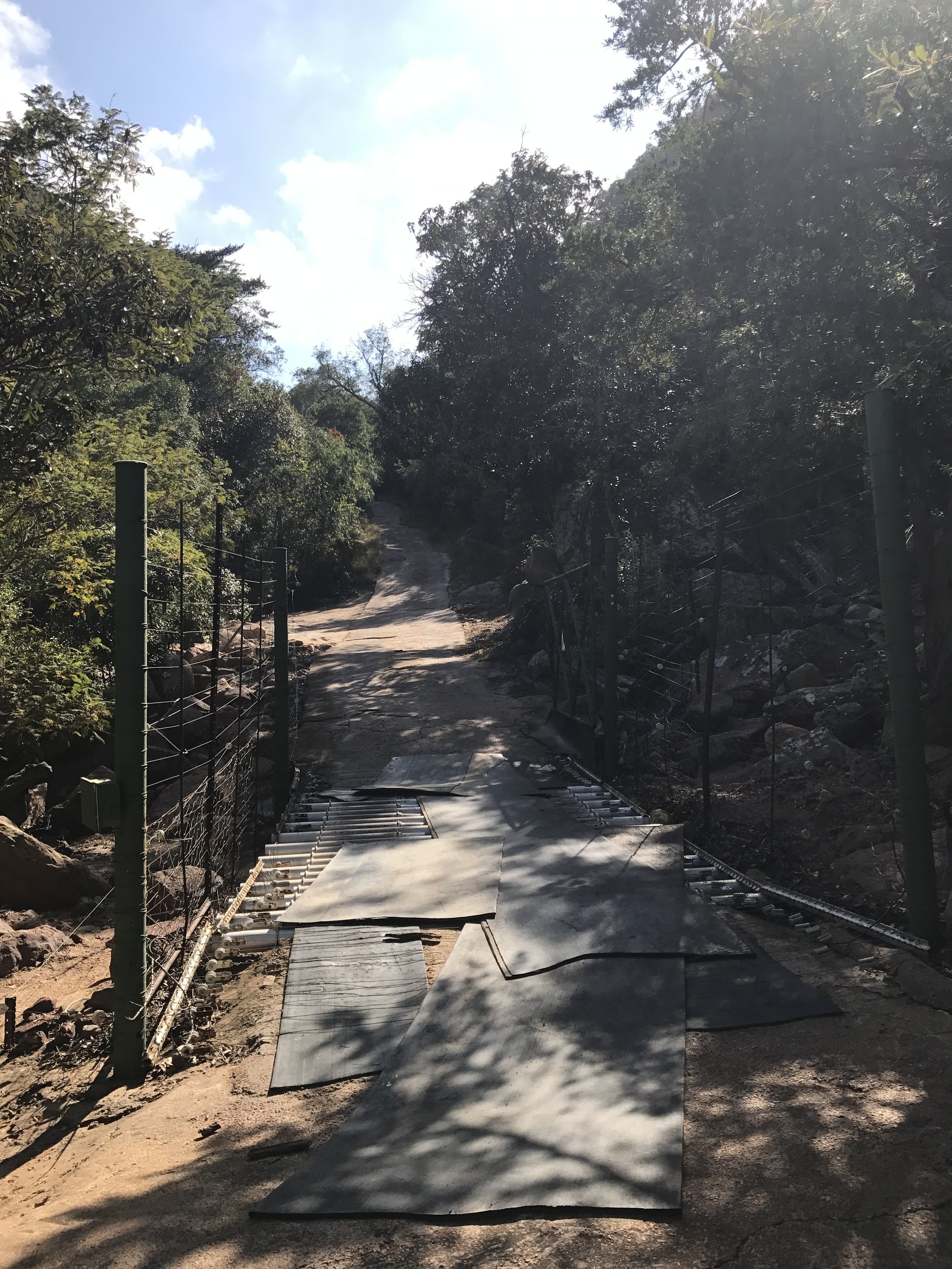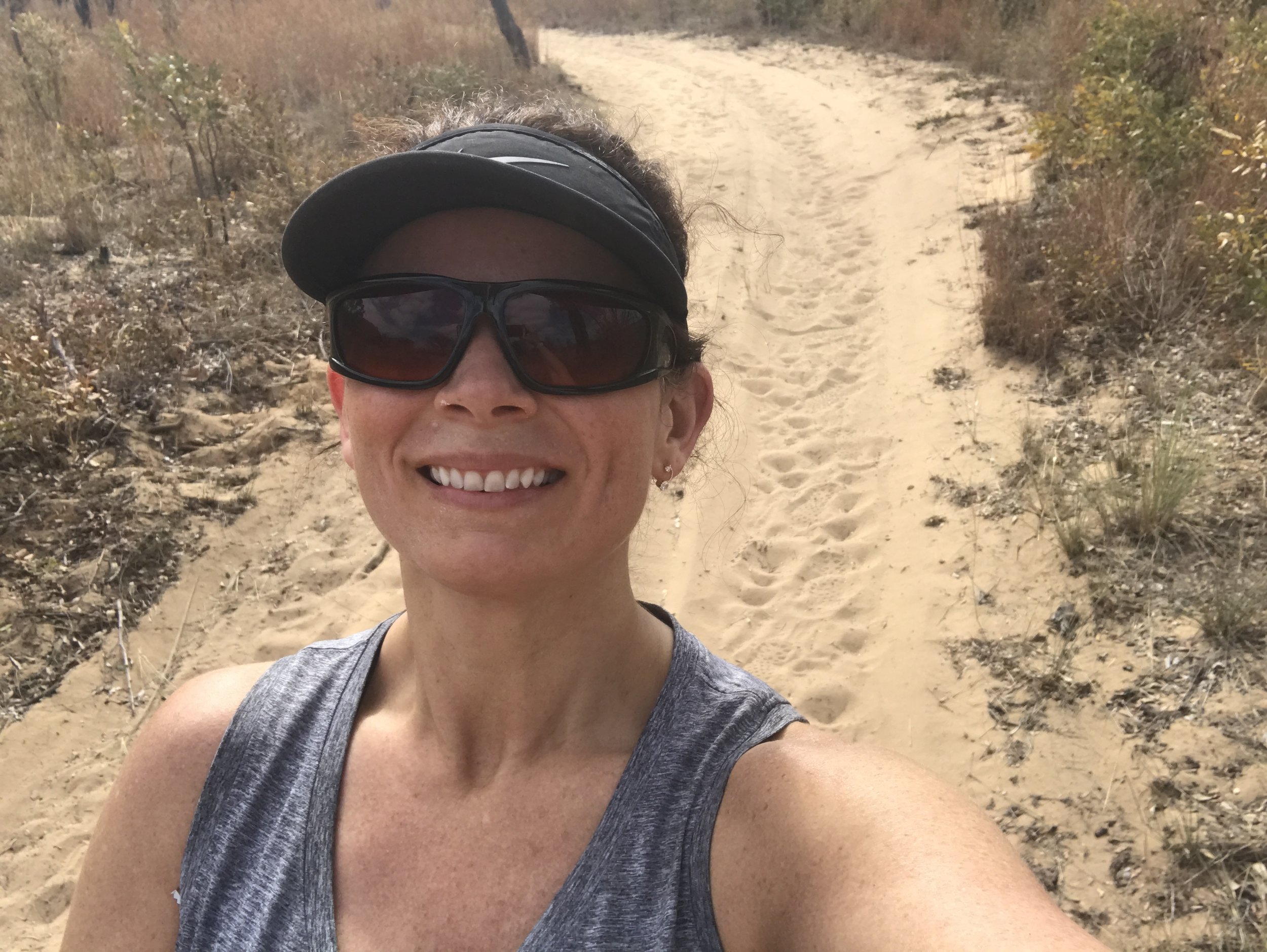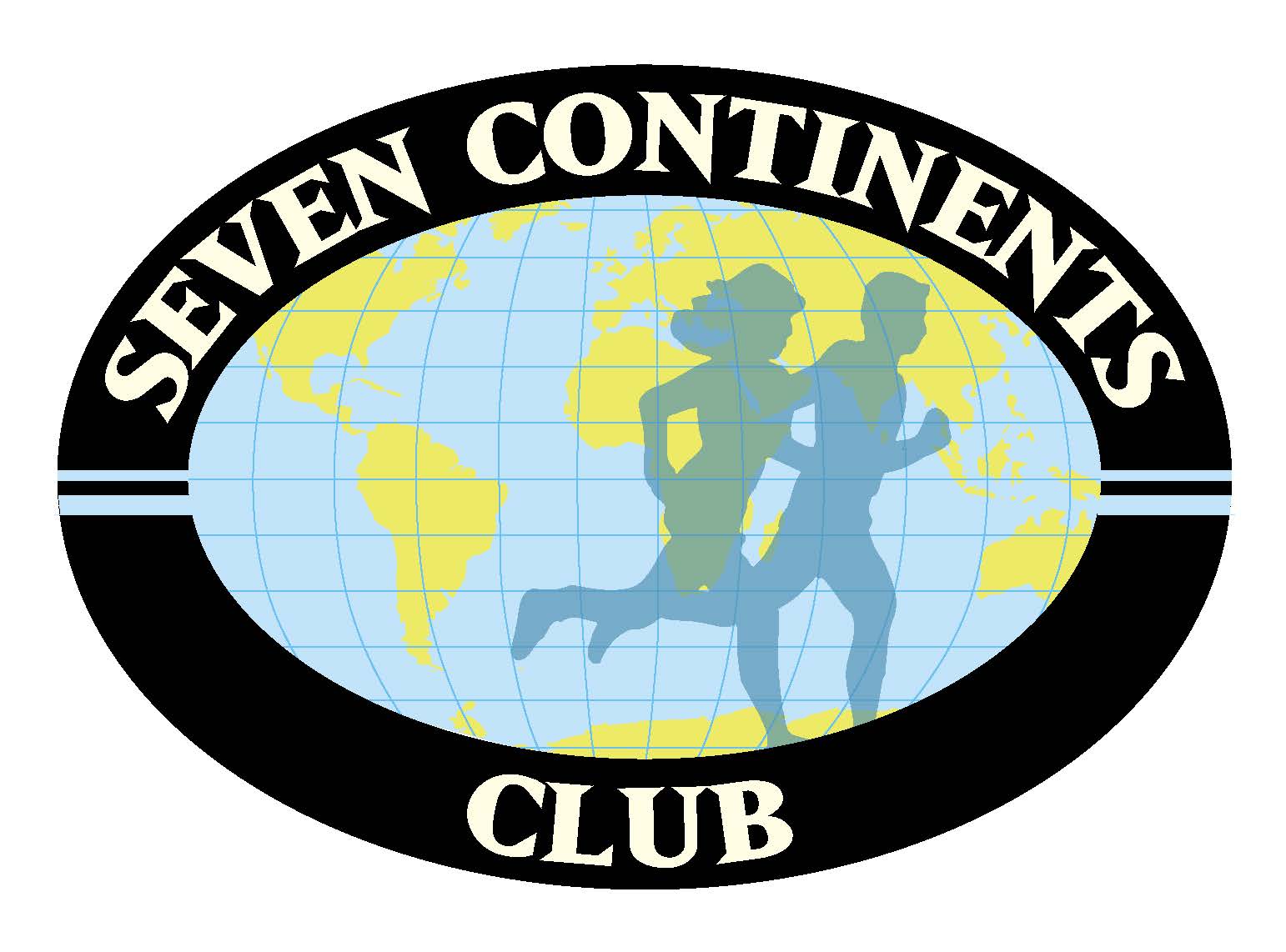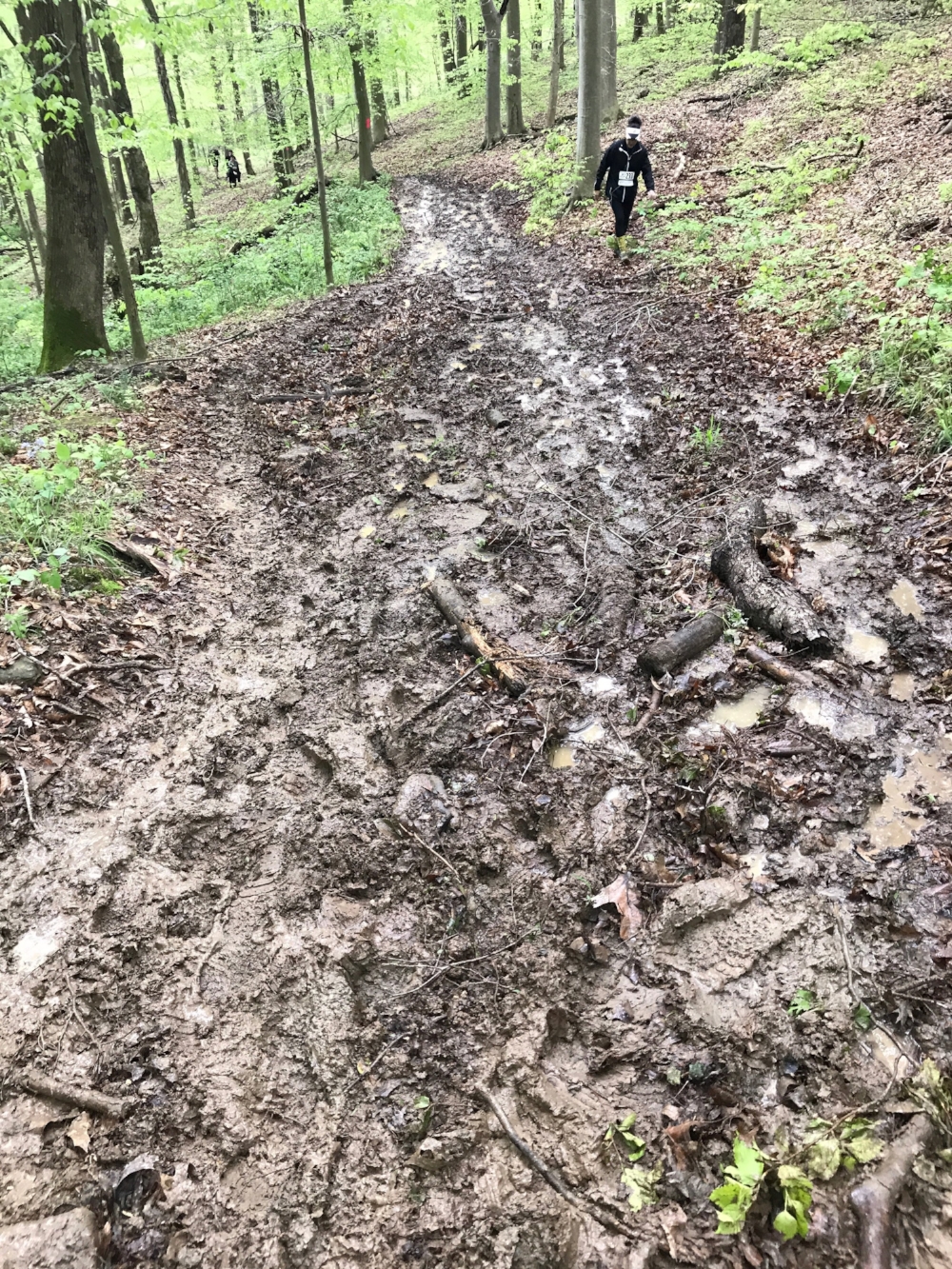The lions were chewing on our mile markers (photo credit - Big Five Marathon FB page)
BIG FIVE MARATHON RACE REPORT
South Africa - June 24, 2017
From the moment I registered for the Big Five Marathon two years ago I was both excited and frightened. "Big Five" refers to the big five game animals in Africa - lion, elephant, buffalo, leopard, and rhinoceros. My previous experience has mostly consisted of flat trails in the Northeast region of the United States at sea level. The Big Five course has 6 miles of deep sand, up to 46% incline and decline on hills, an altitude of almost 6000 feet and African wildlife. I had plenty of reasons to be concerned.
Big Five Marathon Elevation Map and Course Description (Big Five Marathon Website)
'The start and finish line are situated at Lakeside Lodge on the upper escarpment. After the start, the marathon and half marathon routes take the runners past Ravineside Lodge, the Entabeni Monolith and further on to the lower plateau. This first section is run on dirt roads made up of red sand. Runners will pass a few hills (nothing too bad…the worst is yet to come!). And when you reach Hanglip View Point, you backtrack and run back before you reach Yellow Wood Valley. This surface is very uneven with loose rocks, pebbles and holes.
The Yellow Wood Valley is the most dreaded part of the course. You are about to run down the steepest slope of your life! This sharp descent is on a paved surface. The next three kilometres or so will be excruciatingly hard on your quads as you negotiate the steep slope. You reach lion country after the descent. And, although the next nine kilometres are flat, you’re running through deep sand. Full marathoners do a 9km loop, whereas half marathon runners run a 2km loop.
This brings us back to Yellow Wood. And yes, you guessed correctly - we’re going up the dreaded hill this time! Be prepared to take things slowly as it’s virtually impossible to run up this hill.
The route carries on to Long Drive, a narrow valley, where marathon runners do a 6km loop. Half marathoners run across the valley and reach the final section of the route. This section is run on dirt trails, a welcome respite from the deep sand and loose stone terrain earlier on.
The end of the run is fairly hard (final four kilometres). We run halfway down the ridge, which provides us with a wonderful view out over the plateau's lake. The surface is fairly bad, consisting of hard uneven stony ground with plenty of large rocks and stones of all sizes. This final part has quite a few hills and as the surface is loose, it pays to keep a careful watch on the ground as we run towards the finish. With the finish line in sight you can now take it nice and easy.
The weather is very dry, sunny and cool at this time of the year. Participants can expect an average temperature of around 15-20 Celsius, but with variations due to sun, shade, wind and altitude.'
TRAINING DIFFICULTIES AND UNEXPECTED EVENTS
In May 2016 I deferred this race due to an unexpected anemia diagnosis that ultimately resulted in surgery to correct the issue. Knowing I would not complete this challenging course I had no other option. Training in 2017 also had not been ideal with a work schedule that often interfered with scheduled workouts and runs. However, I managed to get approximatley 80% accomplished.
Over the course of training I struggled with nutrition and exhaustion issues due to an erratic and unpredictable weekly travel schedule. As a vegan I often pack food when I travel but some days that is not an option due to logistics. Some meals I opted not to eat airport food therefore resulting in improper muscle recovery. A lack of proper sleep on a normal schedule has contributed to the constant feel of exhaustion. There were numerous 3 AM training runs in unknown cities with a headlamp in freezing temperatures before my 12-14 hour work day began.
Three weeks prior to departing for Johannesburg I began noticing symptoms of an Achilles tendon overuse injury and began having issues with plantar fiscitis. The day of my longest planned trail run, 20 miles, was met with a calf cramp so severe I had to stop at mile 4.7 and limp back to my car. My longest training run for The Big Five was less than 18 miles. Luckily I have a great running coach, Lynn Grieger. She suggested I take it easy until the race. The three week break from running helped physically and mentally and felt very rested as I approached the starting corral.
TRAVEL
I departed Cleveland, Ohio on June 19, five days prior to race day with one extra day as a buffer in Johannesburg in the event of any travel delays. My travel time to Johannesburg was a little over a day including flights, layovers and 6 hour time difference. This did not include the three hour drive from Johannesburg to Entabeni. I arrived at the conservancy on June 21. During the next few days I became acquainted with runners of varying experience from several countries. This was my first time having an opportunity to spend several days with other runners prior to the event was nervous like a student in a new school. It turns out that there was nothing to be worried about! Every one of the participants was welcoming and overflowing with inspiration! One woman in her sixties, Charlotte, had completed marathons on all seven continents. Her total was now at 200 marathons!
THE BIG FIVE MARATHON WEEK BEGINS
We saw this crocodile on our marathon course, two days later I would run down this dirt road.
There was approximately 165 full marathon runners. The course preview the day prior to the event was intimidating. We crawled through the course on a safari Jeep for over 2.5 hours and some of the more experienced runners were expressing fears and doubts about their ability and the potential danger of wildlife. It was later explained to us that the Big Five animals would be routed away from our course the night prior and numerous rangers would be monitoring their location and activity during the race. This made us feel better... at first. Then we realized this did not include the crocodiles, hippopotamus and various animals that were not part of the "Big Five". One interesting fact someone told me the morning of the race is that hippos were responsible for more deaths in Africa than any other animal. That fun fact certainly did not do anything for my already frayed nerves!
Check out this awesome video made on race day!
We can't forget about the hippo family! Very close to the marathon course.
THE RACE
My strategy was a run/walk method - 4 minutes run/ 1 minute walk. Walk the uphills and steep downhills to save energy for the dreaded hill and sand portion. There were several aid stations that had water and earlier in the morning so hydration was not much of a concern. I had two hand held Ultimate Direction water bottles on me and would refill them at each station. I had also placed Nuun and Clif Organic food packets at four of these locations along with a pair of clean socks to change into after the sand portion.
1-5 km - I ran the first 2k but the altitude and continuous incline made it necessary to slow down to a walk. It was apparent early on that my 4 min run/1 min walk strategy was not going to work.
6-10 km - Hills, hills and more hills - the half marathoners split off from us and this section of the course became very uneven. At this point I was seriously worried how I was going to make the cut off of 4:15 at 25.5 km. This seems like a generous time cut off but I knew a challenging descent down the dreaded hill and 6 miles of sand were in front of me.
11-15 km - Marathoners received the plastic bracelets at the turnaround point and there was finally some relief with a gentle downhill slope. At 15 km it becomes apparent that no matter how many times we had seen the "hill" at Yellow Wood Valley into lion country it looked more frightening on foot.
16-25 km - This was a serious hill. The pace has crawled to about 25 min/mile during the descent. Teeny tiny baby steps! Anything else very easily could have lead to a fall with a nasty tumble. I kept looking around at the steep cliffs to my left and right hoping to catch a glimpse of the leopard. No luck but to be honest, falling down this hill became a real concern.
At the bottom of the hill there was an aid station before entering the deep sand. I could tell I was losing focus because I started to go in the wrong direction (which was captured on a race video by a drone). There were locals cheering for us and they directed me back on course. This portion of the course was difficult with several miles of sand but the scenery was so beautiful with an added bonus was wildebeest and giraffe sightings. The cutoff time motivated me to run more than planned. A major blister on my second toe was developing because I had forgotten to put on my gaitors at the last aid station from my drop bag.
25-31.5 km - 25.5 was a relief because the cut off time was behind me! The next best part was the sponge foot wash a change of socks! I had placed a pair of socks in my drop bag along with the forgotten gaitors and fuel packet. This stop was worth the four minutes it took to clean off the sand, assess the toe blister and refuel. This is the location where the race got serious and absolutely miserable. Going up the hill was probably one of the most difficult things I have ever done in my life. 900 feet of elevation gain in about a mile! My pattern became - walk ten steps, stop and take five breaths. This was the only way to get up the hill. I saw some people crawling and others throwing up. My heart rate had sky rocketed to 200 BPM. The motivator - ANOTHER cut off time of 5:15 at 31.5 KM. At this rate the possibility of not making the next cut off time was a concern because my pace had snailed to 41 mins/mile. This was awful but the risk of a heart attack or serious leg cramps kept my pace conservative. The incline averaged 43% during this portion of the course.
At the top of the hill was another aid station with cold spray. Seriously the best thing EVER for leg cramps. I had very little time to waste at this station otherwise I would be picked up off the course. At 28k I befriended an awesome woman from England, Hollie. I forgot how nice it was to have company. We helped each other along and BARELY made the 5:15 cutoff. A race official came up from behind to ask us a question and we thought he was going to pluck us off the course so we ran from him like he was the Grim Reaper! He was only asking how we were doing but we were still mere minutes away from missing the cutoff.
(left) down the hill, (middle) amazing sponge foot wash after 6 miles of sand and back up the hill with electric protective fencing, (right) selfie break from the sand
31.5 - 42.2 km - It's all smooth sailing from here right? WRONG - My Garmin was set to miles not kilometers. With the mental math I thought I had an adequate amount of time after the second cut off to finish the marathon and make the race cut off of 7 hours. It became apparent somewhere around 36-38 that I needed to run not run/walk. This would not have been much of a problem if it was not for the treacherous terrain of loose rocks, more hills and deep grooves combined with poor body form due to tired legs. I had to keep reminding myself to pick up my feet and not shuffle them!
At marker 41 I was certain to make the time. I could hear the music and cheers from the crowd ahead and was able to pick up the pace. There was not a large crowd waiting at the finish line but seeing those friendly faces that were there cheering us on meant the world to me. I finished at 6:56:25, 143 out of 165 runners. It's definitely not a fast time by any means but my goal was to finish and feel good!
WEATHER CONDITIONS ON RACE DAY
Temp 50-65 F - overcast, light wind less than 5 knots
NUTRITION
Clif Organic Energy Food Beet and Banana - I consumed packets during the race and a third one would have been a good idea.
Nuun Energy Tablets - These always work well. I refilled my Nathan handheld twice during the course and put a new tablet in each time.
CLOTHING AND GEAR
Nike Pro Capris - These capris worked like a second skin. Zero complaints and no chaffing!
Nike Featherlight Visor - This visor worked very well allowing heat to escape but keeping the African Savannah sun off of my face.
Flipbelt - It is time to say goodbye to this belt. It is great for shorter runs but there simply is not enough storage space for nutrition, a phone, plus any additional items for a long distance race. - not to mention this is not a photo friendly accessory for most runners. This will be replaced by a hydration vest in the near future.
Ultimate Direction Handheld - These worked fantastic. They have a zippered pouch to hold items and collapse as they become empty. Very light weight. I did not have any arm fatigue carrying these bottle.
Reebok Sleeveless Shirt - 100% polyester. It kept me fairly dry and odor free the entire race.
Blue Blocker Sunglasses - The sunglasses are awesome. I've used them for every run for over two years and they are holding up great!
Garmin 235 Forerunner - Excellent battery life, heart rate and GPS. Programming training runs and races into the app is a breeze!
Moving Comfort Sports Bra - This is a must for women with a size C or larger. It is a bit of a challenge to get on but the support is unbelievable. If you do not believe me, try it!
Injinji socks - This is the first time I have ever gotten a blister but I believe that was from the sand in my shoes. These socks are still my favorite.
Body Glide - No chaffing.






